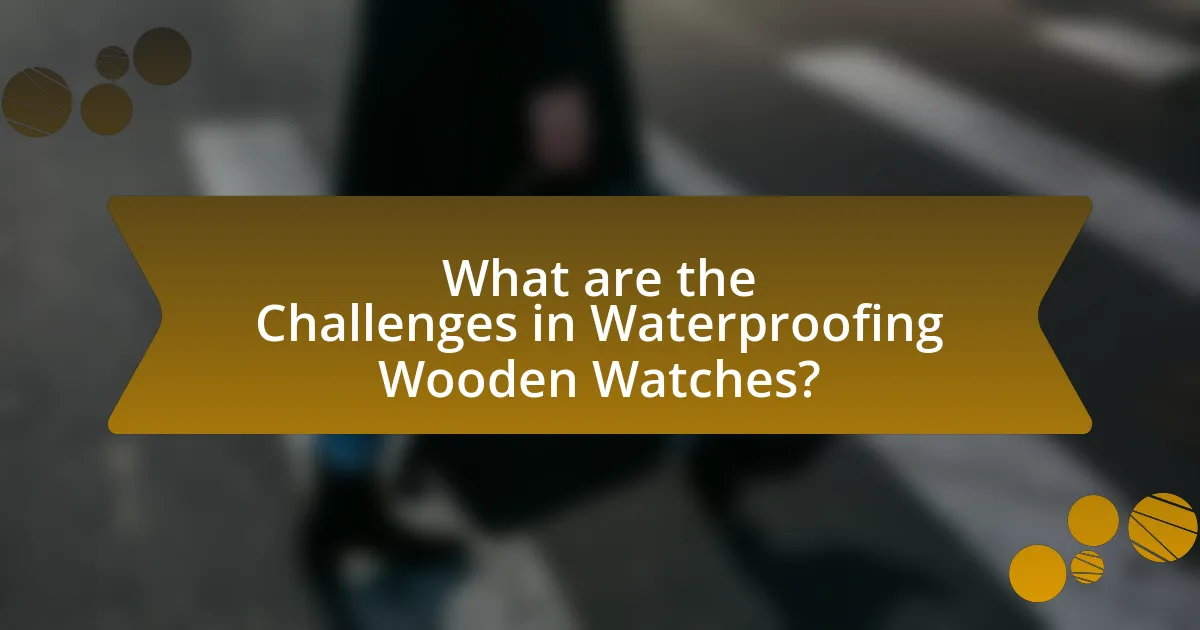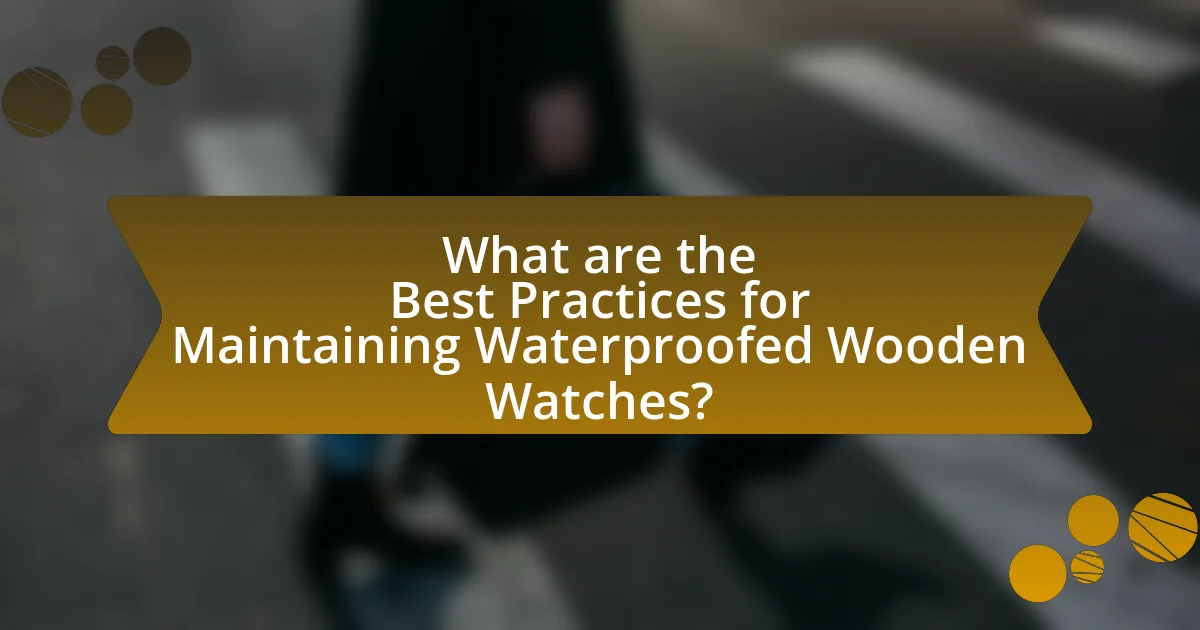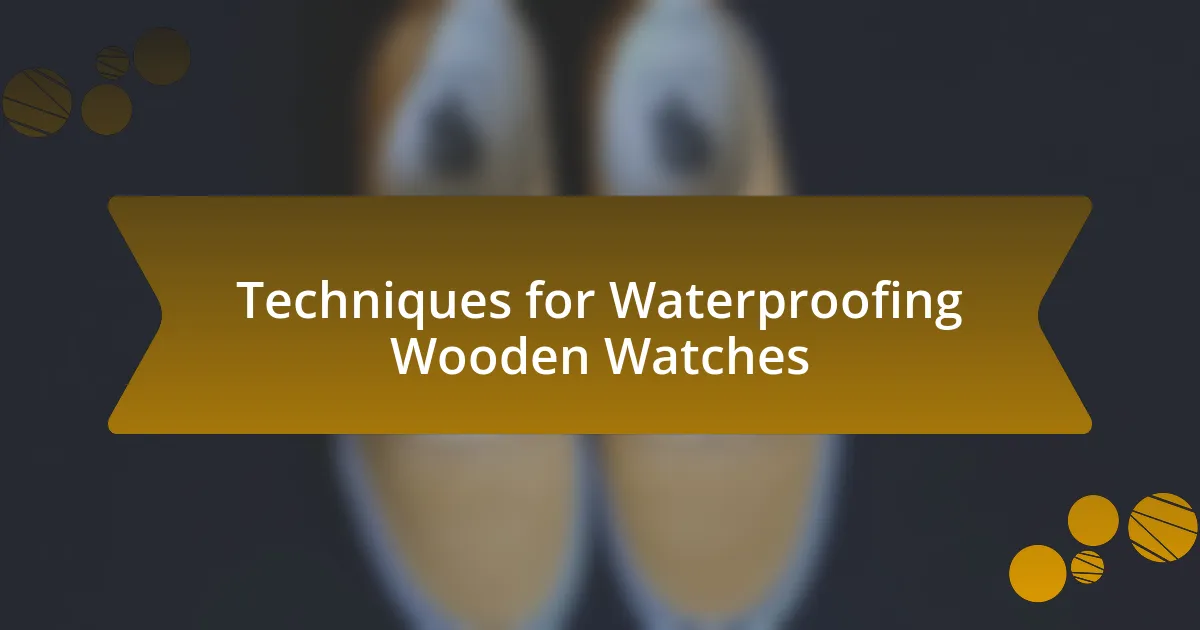The article focuses on techniques for waterproofing wooden watches, detailing methods such as the application of natural oils, sealants, and waterproof coatings. It explains how these techniques protect wooden watches from various types of water damage, including swelling, warping, and discoloration, which can significantly reduce their longevity. The article also discusses the materials commonly used in waterproofing, the best practices for maintaining waterproof integrity, and the challenges faced during the waterproofing process. Additionally, it provides troubleshooting tips for identifying and addressing water damage, ensuring the durability and functionality of wooden watches.

What are the Techniques for Waterproofing Wooden Watches?
The primary techniques for waterproofing wooden watches include applying natural oils, using sealants, and incorporating waterproof coatings. Natural oils, such as tung oil or linseed oil, penetrate the wood and create a moisture-resistant barrier. Sealants, like polyurethane or epoxy, provide a durable layer that protects against water damage while maintaining the wood’s appearance. Waterproof coatings, such as silicone-based sprays, can also be applied to enhance water resistance. These methods are effective in preventing moisture absorption, which can lead to warping or deterioration of the wood.
How do these techniques protect wooden watches from water damage?
Techniques for waterproofing wooden watches protect them from water damage by applying specialized coatings and treatments that create a barrier against moisture. These coatings, often made from natural oils, waxes, or synthetic sealants, penetrate the wood and fill its pores, preventing water from seeping in and causing swelling, warping, or deterioration. For example, the use of tung oil or epoxy resin not only enhances the wood’s appearance but also significantly increases its resistance to water exposure, as these substances form a protective layer that repels moisture.
What types of water damage can affect wooden watches?
Wooden watches can be affected by several types of water damage, including swelling, warping, and discoloration. Swelling occurs when wood absorbs moisture, leading to an increase in size that can compromise the watch’s structure. Warping happens when uneven moisture absorption causes the wood to bend or twist, affecting the watch’s alignment and functionality. Discoloration results from prolonged exposure to water, which can lead to stains or fading of the wood’s natural color. These types of damage highlight the importance of effective waterproofing techniques to protect wooden watches from moisture-related issues.
How does moisture affect the longevity of wooden watches?
Moisture significantly reduces the longevity of wooden watches by causing wood to swell, warp, and potentially crack. When wood absorbs moisture, it expands, which can lead to structural damage and misalignment of watch components. Additionally, prolonged exposure to moisture can promote mold and mildew growth, further deteriorating the wood and affecting the watch’s functionality. Studies indicate that untreated wood can absorb up to 30% of its weight in water, emphasizing the importance of effective waterproofing techniques to enhance durability and lifespan.
What materials are commonly used in waterproofing wooden watches?
Common materials used in waterproofing wooden watches include natural oils, waxes, and synthetic sealants. Natural oils, such as tung oil and linseed oil, penetrate the wood and create a moisture-resistant barrier. Waxes, like beeswax, provide a protective coating that repels water while allowing the wood to breathe. Synthetic sealants, such as polyurethane or epoxy, offer a durable waterproof layer that can withstand exposure to moisture. These materials are effective in enhancing the longevity and functionality of wooden watches by preventing water damage.
What are the benefits of using natural oils for waterproofing?
Natural oils provide several benefits for waterproofing, particularly in the context of wooden watches. They create a protective barrier that repels water, preventing moisture absorption and potential damage to the wood. Additionally, natural oils enhance the wood’s appearance by enriching its color and grain, while also providing a degree of flexibility that helps maintain the integrity of the wood over time. Research indicates that oils like tung oil and linseed oil have been traditionally used for their water-resistant properties, effectively sealing the wood and prolonging its lifespan.
How do synthetic sealants compare to natural options?
Synthetic sealants generally offer superior durability and water resistance compared to natural options. While natural sealants, such as oils and waxes, can provide a certain level of protection, they often require more frequent reapplication and may not withstand harsh environmental conditions as effectively as synthetic alternatives. For instance, synthetic sealants can resist UV damage and moisture penetration better, making them more suitable for long-term waterproofing of wooden watches. Studies have shown that synthetic sealants can last several years longer than natural options, providing a more reliable barrier against water and humidity.
What are the steps involved in waterproofing a wooden watch?
The steps involved in waterproofing a wooden watch include cleaning the wood, applying a sealant, and testing for water resistance. First, the wood must be thoroughly cleaned to remove any dirt or oils that could prevent proper adhesion of the sealant. Next, a waterproof sealant, such as a marine-grade varnish or a specialized wood finish, should be evenly applied to all surfaces of the watch, ensuring complete coverage. Finally, after the sealant has dried, the watch should be tested for water resistance by submerging it in water for a specified duration to confirm that no moisture penetrates the wood. These steps are essential to protect the integrity of the wooden watch and enhance its durability against water exposure.
How should the wood be prepared before applying waterproofing techniques?
Wood should be sanded and cleaned before applying waterproofing techniques. Sanding the wood smooths the surface, removes any existing finishes, and opens up the pores, allowing the waterproofing agent to penetrate effectively. Cleaning the wood involves removing dust, dirt, and oils, which can hinder adhesion. A clean, sanded surface ensures optimal bonding of the waterproofing material, enhancing its effectiveness in protecting the wood from moisture damage.
What application methods are most effective for waterproofing?
The most effective application methods for waterproofing wooden watches include spray application, brush application, and immersion techniques. Spray application allows for an even coat and penetrates the wood fibers effectively, while brush application provides control for detailed areas. Immersion techniques ensure complete saturation of the wood, which is crucial for maximum waterproofing. Research indicates that these methods enhance the durability and water resistance of wooden materials, making them suitable for watchmaking.

What are the Challenges in Waterproofing Wooden Watches?
The challenges in waterproofing wooden watches primarily stem from the inherent properties of wood, which is porous and susceptible to moisture absorption. This porosity makes it difficult to create a completely waterproof barrier without compromising the aesthetic and structural integrity of the wood. Additionally, traditional waterproofing methods, such as coatings or sealants, may not adhere well to wood surfaces or could alter the wood’s appearance and texture. Furthermore, the natural expansion and contraction of wood due to humidity and temperature changes can lead to cracks in the waterproofing layer, ultimately allowing water to penetrate. These factors highlight the complexity of effectively waterproofing wooden watches while maintaining their design and functionality.
What common mistakes should be avoided during the waterproofing process?
Common mistakes to avoid during the waterproofing process include inadequate surface preparation, improper application of waterproofing agents, and neglecting to follow manufacturer instructions. Inadequate surface preparation can lead to poor adhesion, resulting in water penetration; for instance, failing to clean or sand the wood properly can compromise the waterproofing effectiveness. Improper application, such as applying too thick a layer or not allowing sufficient drying time between coats, can also hinder performance. Lastly, neglecting to follow manufacturer instructions can result in using incompatible products or incorrect application techniques, which can ultimately lead to failure in waterproofing.
How can improper application affect the watch’s appearance and function?
Improper application of waterproofing techniques can lead to significant deterioration in both the appearance and function of a wooden watch. When waterproofing agents are not applied evenly or in the correct amounts, it can result in unsightly streaks, discoloration, or a cloudy finish on the wood surface. Additionally, inadequate sealing can allow moisture to penetrate, leading to warping, swelling, or even mold growth, which compromises the structural integrity of the watch. Research indicates that wooden materials are particularly susceptible to environmental factors, and a study by the Journal of Wood Science highlights that improper treatment can reduce the lifespan of wooden products by up to 50%. Thus, ensuring proper application is crucial for maintaining both the aesthetic and functional qualities of wooden watches.
What are the risks of using the wrong waterproofing materials?
Using the wrong waterproofing materials can lead to significant risks, including damage to the wooden structure, compromised durability, and aesthetic degradation. When inappropriate materials are applied, they may not effectively repel water, leading to swelling, warping, or cracking of the wood. Additionally, certain chemicals in unsuitable waterproofing agents can react negatively with the wood, causing discoloration or deterioration over time. For instance, a study published in the Journal of Wood Science highlights that improper waterproofing can reduce the lifespan of wooden products by up to 50%, emphasizing the importance of selecting the right materials for effective protection.
How can environmental factors impact the effectiveness of waterproofing?
Environmental factors significantly impact the effectiveness of waterproofing by influencing the material’s ability to repel water and resist degradation. For instance, high humidity can lead to the absorption of moisture by wooden materials, compromising the waterproofing layer’s integrity. Additionally, exposure to extreme temperatures can cause expansion and contraction in wood, which may create gaps in the waterproof barrier. Research indicates that prolonged exposure to UV radiation can degrade waterproof coatings, reducing their effectiveness over time. Therefore, environmental conditions such as humidity, temperature fluctuations, and UV exposure directly affect the durability and performance of waterproofing techniques used on wooden watches.
What role does humidity play in the performance of waterproofing techniques?
Humidity significantly affects the performance of waterproofing techniques by influencing the absorption and effectiveness of waterproofing materials. High humidity can lead to increased moisture content in wood, which may compromise the adhesion of waterproofing agents and reduce their efficacy. For instance, studies indicate that wood treated with waterproofing solutions in high humidity conditions may not achieve optimal penetration, resulting in diminished protective qualities. Therefore, controlling humidity levels during the application of waterproofing techniques is crucial for ensuring their long-term effectiveness in protecting wooden watches.
How does temperature affect the curing process of waterproofing materials?
Temperature significantly influences the curing process of waterproofing materials, as higher temperatures generally accelerate the curing time while lower temperatures can slow it down. For instance, many waterproofing materials, such as polyurethane and epoxy, require specific temperature ranges to achieve optimal curing; typically, temperatures above 50°F (10°C) enhance the chemical reactions necessary for curing. Conversely, temperatures below this threshold can lead to incomplete curing, resulting in compromised waterproofing effectiveness. Studies have shown that at temperatures around 70°F (21°C), curing can occur within hours, whereas at 40°F (4°C), the process may extend to days or even weeks, demonstrating the critical role temperature plays in ensuring the integrity of waterproofing applications on wooden watches.

What are the Best Practices for Maintaining Waterproofed Wooden Watches?
To maintain waterproofed wooden watches effectively, regularly clean the watch with a soft, damp cloth to remove dirt and moisture. This practice prevents buildup that can compromise the waterproof seal. Additionally, avoid exposing the watch to extreme temperatures and direct sunlight, as these conditions can warp the wood and damage the waterproofing. It is also advisable to periodically check the integrity of the waterproof seal, especially after exposure to water, and to reapply a suitable waterproofing treatment as recommended by the manufacturer. These steps ensure the longevity and functionality of the waterproof features in wooden watches.
How can owners ensure the longevity of their waterproofed wooden watches?
Owners can ensure the longevity of their waterproofed wooden watches by regularly maintaining the watch’s seal and finish. This involves cleaning the watch with a soft, damp cloth to remove dirt and moisture, and applying a suitable wood conditioner or oil to preserve the wood’s integrity. Regular inspections for any signs of wear or damage to the waterproof seal are crucial, as even minor breaches can compromise the watch’s waterproof capabilities. Additionally, storing the watch in a dry environment and avoiding exposure to extreme temperatures or humidity can further enhance its durability. These practices are supported by the fact that wood, being a natural material, is susceptible to environmental factors, and proper care can significantly extend its lifespan.
What routine care is recommended for maintaining waterproof integrity?
Routine care for maintaining waterproof integrity includes regular cleaning, inspection for damage, and reapplication of waterproofing treatments. Cleaning should be done with a damp cloth to remove dirt and moisture, while inspections should focus on checking seals and gaskets for wear or degradation. Reapplying waterproofing treatments, such as oils or waxes specifically designed for wood, helps restore the protective barrier. These practices are essential because they prevent water ingress, which can lead to damage and deterioration of the wooden components in watches.
How often should waterproofing be reapplied to wooden watches?
Waterproofing should be reapplied to wooden watches every six months to one year, depending on usage and exposure to moisture. Regular maintenance is essential because wood is porous and can absorb water, leading to damage. Factors such as humidity, frequency of wear, and exposure to water can affect how often the waterproofing needs to be reapplied. Regular checks and timely reapplication help maintain the integrity and longevity of the wooden watch.
What troubleshooting tips can help with waterproofed wooden watches?
To troubleshoot issues with waterproofed wooden watches, first ensure that the watch is properly sealed by checking the gaskets and seals for any signs of wear or damage. If water has entered the watch, immediately remove it from moisture and allow it to dry completely in a dry environment, as prolonged exposure can cause damage to the wood and movement. Additionally, consider applying a waterproofing oil or wax specifically designed for wooden watches to enhance their water resistance. Regular maintenance, including reapplying waterproofing treatments every few months, can also prevent future issues. These steps are essential because waterproofed wooden watches rely on effective sealing and maintenance to function properly in wet conditions.
How can one identify signs of water damage despite waterproofing?
One can identify signs of water damage despite waterproofing by examining for discoloration, warping, or swelling in the wood. These physical changes indicate that moisture has penetrated the protective barrier. Additionally, the presence of mold or mildew, often visible as dark spots, serves as a clear indicator of water exposure. Regular inspections for these signs are crucial, as waterproofing can degrade over time, leading to potential damage. Research shows that even high-quality waterproofing treatments can fail, especially if the wood is not properly maintained, making vigilance essential for preservation.
What steps should be taken if water damage is detected?
If water damage is detected, the first step is to immediately remove the watch from any water source and dry it thoroughly. This involves wiping the exterior with a soft cloth and placing the watch in a dry, well-ventilated area to allow moisture to escape. Next, it is crucial to assess the extent of the damage; if the watch is still functioning, monitor its performance closely. If the watch shows signs of malfunction, such as fogging under the glass or erratic timekeeping, professional servicing is recommended to prevent further damage. According to the American Watchmakers-Clockmakers Institute, timely intervention can significantly reduce the risk of permanent damage to the internal mechanisms of the watch.
